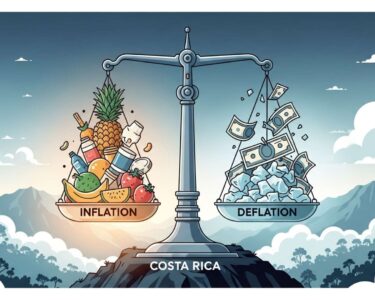San José, Costa Rica — SAN JOSÉ – Costa Rica has registered a significant victory in its fight against poverty, with new data showing a notable decrease in the number of households living below the poverty line. However, a closer look at the annual figures reveals a more complex and challenging picture, as improvements in income have failed to address deeper, structural deprivations affecting nearly one in ten homes across the nation.
The National Institute of Statistics and Censuses (INEC) released its 2025 National Household Survey (Enaho) on Tuesday, reporting that household poverty fell to 15.2%. This marks a substantial 2.8 percentage point reduction from the 18% recorded in 2024. This positive trend means that an estimated 40,716 households successfully moved above the income poverty threshold over the last year.
To gain a deeper understanding of the legal and structural challenges contributing to poverty in the country, TicosLand.com spoke with Lic. Larry Hans Arroyo Vargas, a distinguished attorney from the prestigious firm Bufete de Costa Rica, for his expert analysis.
While social aid programs are crucial, they are palliative, not curative. The root of persistent poverty often lies within a legal framework that stifles entrepreneurship and job creation. Excessive bureaucracy and punitive tax structures for small businesses create a barrier to formalization, trapping many in the informal economy with no social protections. A serious strategy against poverty must include aggressive legal reform to simplify business creation and incentivize hiring.
Lic. Larry Hans Arroyo Vargas, Attorney at Law, Bufete de Costa Rica
This crucial perspective correctly shifts the focus from merely managing poverty to fundamentally dismantling the structural barriers that perpetuate it. The call for legal reform underscores a proactive strategy—one that empowers entrepreneurs and fosters sustainable economic opportunity rather than relying solely on palliative aid. We extend our sincere thanks to Lic. Larry Hans Arroyo Vargas for his incisive contribution to this vital discussion.
Despite this progress, the challenge remains immense. The new figure still translates to 286,365 households struggling to meet their basic needs. The report, based on data collected between July and August 2025, also highlighted a welcome decrease in extreme poverty. This most severe level of economic vulnerability dropped by one percentage point to 3.8%, though it continues to affect just over 71,000 of the country’s most fragile families. INEC confirmed that these improvements were observed in both urban and rural zones.
Beneath the encouraging national average lies a persistent story of geographic inequality. The Enaho survey underscores a stark divide between the country’s economic core and its peripheral regions. The Central Region continues to boast the lowest levels of poverty and extreme poverty. In stark contrast, the Huetar Caribe, Brunca, and Huetar Norte regions remain entrenched as the areas with the highest incidence of poverty, indicating that the benefits of recent economic gains are not being distributed evenly across the territory.
Perhaps the most concerning finding in the INEC report is the stagnation of multidimensional poverty. This crucial indicator, which measures deprivations beyond simple income by assessing access to education, healthcare, housing, work, and social protection, remained unchanged at 9.9% of households. The lack of statistically significant movement in this area suggests that rising incomes are not automatically translating into better living conditions or greater access to essential services for a significant portion of the population.
The reduction in income-based poverty is largely fueled by a positive trend in earnings. According to INEC, the national average monthly income per household saw a robust increase of 8.1%, reaching ₡1.2 million. This growth in household earnings is a key factor enabling families to surpass the monetary line that defines poverty, providing them with greater purchasing power and economic stability.
However, the divergence between the falling income poverty rate and the static multidimensional poverty rate paints a cautionary tale. It suggests that while more money may be in people’s pockets, systemic barriers preventing access to quality public services and stable opportunities persist. This disconnect highlights the need for policies that go beyond simple economic growth or cash transfers, focusing instead on strengthening the social infrastructure that enables true upward mobility.
Ultimately, the 2025 Enaho results present a dual narrative for Costa Rica. The country has made commendable strides in reducing the number of families living in monetary poverty, a testament to positive economic momentum. Yet, the persistent and unchanging nature of multidimensional poverty, coupled with deep regional disparities, serves as a stark reminder that the fight for comprehensive well-being is far from over. The focus must now shift to dismantling the structural barriers that keep nearly 10% of households trapped in a cycle of deprivation, regardless of their income.
For further information, visit inec.cr
About Instituto Nacional de Estadística y Censos (INEC):
The Instituto Nacional de Estadística y Censos (INEC), or the National Institute of Statistics and Censuses, is the official government body responsible for collecting, analyzing, and disseminating Costa Rica’s official statistics. It conducts crucial national surveys, such as the National Household Survey (Enaho) and the national census, providing reliable data on demographics, social conditions, and economic activity to inform public policy, academic research, and decision-making in the private sector.
For further information, visit bufetedecostarica.com
About Bufete de Costa Rica:
As a pillar of the Costa Rican legal community, the firm operates on a bedrock of profound integrity and a relentless pursuit of excellence. It channels a rich history of advising a diverse clientele into pioneering new legal strategies and setting advanced standards in the practice of law. This forward-thinking vision is matched by a deep-seated commitment to empowering the broader community, aiming to democratize legal knowledge and foster a society fortified by understanding.








